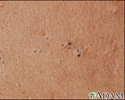Comedones
Skin bumps - acne-like; Acne-like skin bumps; Whiteheads; Blackheads
Comedones are small, flesh-colored, white, or dark bumps that give skin a rough texture. The bumps are caused by acne . They are found at the opening of skin pores. A solid core can often be seen in the middle of the small bump. Open comedones are blackheads and closed comedones are whiteheads .
Acne
Acne is a skin condition that causes pimples or "zits. " Whiteheads, blackheads, and red, inflamed patches of skin (such as cysts) may develop....

Blackheads
Blackheads are tiny, dark spots on the skin. They are caused by a small plug in the opening of a follicle (pore). Blackheads are also called open c...

Whiteheads
Whiteheads are small, white, raised bumps on the skin. They form when oil and skin collect in the pores. Whiteheads are also known as closed comedo...

References
Habif TP. Acne, rosacea, and related disorders. In: Habif TP, ed. Clinical Dermatology . 6th ed. Philadelphia, PA: Elsevier; 2016:chap 7.
Patterson JW. Diseases of cutaneous appendages. In: Patterson JW, ed. Weedon's Skin Pathology . 4th ed. Philadelphia, PA: Elsevier Churchill Livingstone; 2016:chap 15.
-
Acne - close-up of pustular lesions - illustration
Acne lesions frequently contain pus. This close-up photograph shows small acne pustules with surrounding inflammation (erythema).
Acne - close-up of pustular lesions
illustration
-
Blackheads (comedones) - illustration
Blackheads, or open comedones, are common in acne. Clogged hair follicles reflect light irregularly to produce this black hue.
Blackheads (comedones)
illustration
-
Blackheads (comedones) close-up - illustration
Blackheads, or open comedones, are common in acne. Clogged hair follicles reflect light irregularly to produce this black hue.
Blackheads (comedones) close-up
illustration
-
Acne, cystic on the chest - illustration
Cystic acne may occur across the upper chest as well as on the back.
Acne, cystic on the chest
illustration
-
Acne, cystic on the face - illustration
The face is the most common location of acne. Here, there are 4 to 6 millimeter red (erythematous) pustules, some with bridging scars and fistulous tract formation (connecting passages). Severe acne may have a profound psychological impact and may cause scarring. Effective treatments are available for this type of acne.
Acne, cystic on the face
illustration
-
Acne, vulgaris on the back - illustration
Acne frequently occurs on the back. Here, there are 2 to 6 millimeter wide erythematous (red) pustules with large open and closed comedones. Permanent scarring may follow a severe case of acne. Men are more often affected on their shoulders and back than are women.
Acne, vulgaris on the back
illustration
-
Acne, close-up of cysts on the back - illustration
Cystic acne, or nodulocystic acne, is the most severe form of acne. Both pustules and hard red bumps are present in the skin. This form of acne is more difficult to treat and often requires taking an oral vitamin A derivative.
Acne, close-up of cysts on the back
illustration
-
Acne, cystic on the back - illustration
Cystic acne, or nodulocystic acne, is the most severe form of acne. Both pustules and red bumps are present in the skin and scarring can be seen. The back is a common site for acne.
Acne, cystic on the back
illustration
-
Acne - close-up of pustular lesions - illustration
Acne lesions frequently contain pus. This close-up photograph shows small acne pustules with surrounding inflammation (erythema).
Acne - close-up of pustular lesions
illustration
-
Blackheads (comedones) - illustration
Blackheads, or open comedones, are common in acne. Clogged hair follicles reflect light irregularly to produce this black hue.
Blackheads (comedones)
illustration
-
Blackheads (comedones) close-up - illustration
Blackheads, or open comedones, are common in acne. Clogged hair follicles reflect light irregularly to produce this black hue.
Blackheads (comedones) close-up
illustration
-
Acne, cystic on the chest - illustration
Cystic acne may occur across the upper chest as well as on the back.
Acne, cystic on the chest
illustration
-
Acne, cystic on the face - illustration
The face is the most common location of acne. Here, there are 4 to 6 millimeter red (erythematous) pustules, some with bridging scars and fistulous tract formation (connecting passages). Severe acne may have a profound psychological impact and may cause scarring. Effective treatments are available for this type of acne.
Acne, cystic on the face
illustration
-
Acne, vulgaris on the back - illustration
Acne frequently occurs on the back. Here, there are 2 to 6 millimeter wide erythematous (red) pustules with large open and closed comedones. Permanent scarring may follow a severe case of acne. Men are more often affected on their shoulders and back than are women.
Acne, vulgaris on the back
illustration
-
Acne, close-up of cysts on the back - illustration
Cystic acne, or nodulocystic acne, is the most severe form of acne. Both pustules and hard red bumps are present in the skin. This form of acne is more difficult to treat and often requires taking an oral vitamin A derivative.
Acne, close-up of cysts on the back
illustration
-
Acne, cystic on the back - illustration
Cystic acne, or nodulocystic acne, is the most severe form of acne. Both pustules and red bumps are present in the skin and scarring can be seen. The back is a common site for acne.
Acne, cystic on the back
illustration
Review Date: 10/31/2016
Reviewed By: Kevin Berman, MD, PhD, Atlanta Center for Dermatologic Disease, Atlanta, GA. Review provided by VeriMed Healthcare Network. Also reviewed by David Zieve, MD, MHA, Isla Ogilvie, PhD, and the A.D.A.M. Editorial team.








